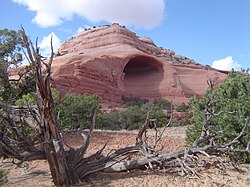Locations on Earth
North Pole

Although alcoves are both found in the northern and southern hemisphere, more newly developed alcoves are in the northern hemisphere region. Around the North Pole, dune alcoves, dune furrows, and scarp avalanches can form. [2] The mechanism dune furrows are formed are through cryo jets and many form at alluvial fans. Furrows are channels and although mostly small they can vary in size and everytime they form in the spring season. Furrows do not have a long lifetime as they are often blown away by strong summer winds.
South Pole
In comparison, the South Pole differs in having higher elevation which can cause changes in alcove formation. These differences include the South Pole having older alcoves due to its denser deposition craters which are approximately 2 to 3 m thick which include particles of ice and minerals, and craters that contains carbon dioxide ice. [2] Both South Pole and North Pole alcoves are formed through stress cementing the sandstone particles together. So after erosion, at the area where the most rock has been excavated by weathering the pressure builds up and the sand particles become very stable and hold the arch above. [1]
